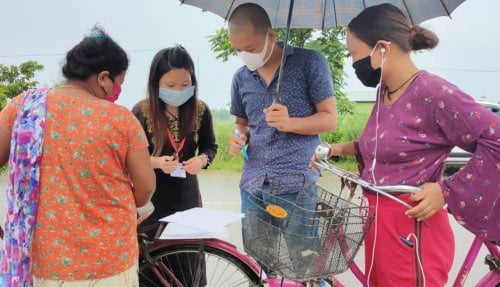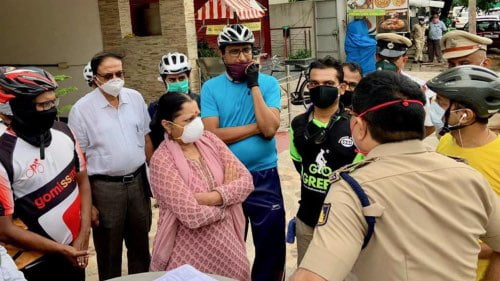Finally, a cycling revolution has taken over the country with the ‘India Cycles4Change’ challenge beginning to gain momentum in our cities. The challenge was launched – on 25 June 2020 – under the Smart Cities Mission by the Ministry of Housing and Urban Affairs in view of growing COVID pandemic in the country. Around a year later, cycling has become a crucial mode of safe and healthy transport medium that ensures social distancing while being environmentally sustainable.
Cycling saw a huge rise in demand as the COVID-19 pandemic spread across the country. The public transport commuters affected by lockdown restrictions found cycling as a personal and COVID-safe alternative for short and medium distance travel. Plus, cycling was also considered as a means to stay physically and mentally healthy while the people who were confined to their homes.
With the launch of ‘India Cycles4Change’ challenge, 107 cities registered themselves for the initiative and 41 cities undertook measures such as surveys, discussions, pop-up cycle lanes, safer neighbourhoods, open street events, cycle rallies and online campaigns that were aimed at creating a cycle friendly environment.
Under this campaign, the cities launched initiatives covering approx. 400 kms of arterial roads and over 3500 kms of neighbourhood streets. The Smart Cities Mission, in association with Institute for Transport and Development Policy (ITDP) conducted training modules and other capacity building initiatives to guide 107 cities on various cycling initiatives.

How Cycling challenge progressed after launching
The challenge had a Test-Learn-Scale (TLS) approach which the participating cities adopted by testing various initiatives through quick low-cost interventions in the first phase of the challenge, learning from them, and preparing for scale up in the second phase. The key intervention areas identified for piloting of solutions were:
1. Identifying barriers to cycling by listening to the people
- Cities undertook perception surveys to understand the needs of citizens with regard to cycling.
- Cities conducted surveys and interviews and engaged with more than 60,000 people across the country.
- The engagement initiatives included people from diverse usergroups, from postmen in Rajkot to women in Hubli Dharwad and Kakinada and children in Aizawl.
2. Making streets and neighbourhoods safe and fun for cycling
- Cities created dedicated cycle lanes to help cyclists ride safely.
- Cities like Bhubaneswar, Surat, Kochi, Greater Warangal used traffic cones, bollards, and paints to test out interventions. Aurangabad reused tyres as planters to segregate their cycle lanes from motor vehicle traffic.
- Cities like Vadodara and Gurugram made intersections safer for cyclists and pedestrians to cross by painting colourful crosswalks. Chandigarh also installed cycle signals to prioritise cyclists at junctions.
- To make neighbourhood streets safer for everyone, cities like Bangalore and Jabalpur designated ‘slow zones’, restricting motor vehicle speed through speed breakers, chicanes, and road signs.
- New Delhi created a cycle plaza for children in the Lodhi Garden Colony by rerouting vehicular traffic.
3. Creating a cycling community
- Local Civil Society Organisations were engaged/entrusted with the task of conducting various events to bring the cycling community together.
- Cities like Pimpri Chinchwad, Kohima, Great Warangal, Nagpur and Panaji hosted rallies and cyclothons bringing thousands of cyclists onto the streets.
- In neighbourhoods, open street events allowed people to walk, jog, play and cycle which built the confidence of women, children, and new cyclists.
- Cities such as Jabalpur, New Town Kolkata hosted cycle repair clinics to make cycle service accessible and affordable, encouraging more people to come out.
- As a direct impact of these pilots, many RWAs demanded cycling-friendly neighbourhoods from their city authorities.
4. Empowering women to cycle
- Many cities including Nashik, New Town Kolkata, and Bengaluru hosted cycle training camps for older women, boosting their confidence to cycle.
- To improve access to cycles, Kohima, Rajkot, and Chandigarh launched cooperative cycle rental schemes and public bicycle sharing systems in neighbourhoods.
- These initiatives were particularly empowering for women, giving them an affordable means to move freely in their cities.

5. Changing everyday behaviour through campaigns
- Cities such as Rajkot and Jabalpur launched Cycle2Work campaigns, where senior officials of the government pedalled to office to inspire citizens.
- In Rajkot, the city administration distributed cycles to employees and awarded them for their efforts. Other business organisations also embraced the Cycle2Work campaign offering incentives to employees inducing a shift to cycling.
Having tested and learnt from these pilots, cities are now developing cycling plans to scale-up these initiatives across their cities to achieve the goals set out in the policy. This will lead the way for different government departments and citizens to work together towards a walking and cycling-friendly nation.
What is the way forward in the cycling revolution?
As a part of post Covid recovery plans, cities across the world are quickly testing cycling infrastructure and then making it permanent to rebuild. The pandemic has also highlighted the need for affordable and sustainable options for women’s mobility to compete in a post-COVID 19 economy. Cycling can play an important role to address this as a sustainable and equitable mode of transport.
In the future, cities must meet the needs of all residents within 15 minutes of walk, cycle and public transport. This will reduce carbon emissions, increase safety and enhance liveability.
The pandemic is an opportunity for cities to reinvent themselves. Through quick and easy interventions, more Indian cities can support the vulnerable population during this crisis, while also strengthening social, economic, and environmental development.
As per ITDP reports, investments in cycling infrastructure have economic benefits of up to 5.5 times the initial investment. Cycling for short distances can result in an annual benefit of INR 1.8 trillion to the Indian economy. Indian cities must prioritise cycling, walking, and public transport to build resilience to face future pandemics but to also effectively tackle climate change.









Will Amarinder Singh prove BSY for BJP in Punjab?
Afghanistan crisis: Subjugation of a nation and the Taliban rule
Two-child policy: BJP’s masterstroke before elections in UP?